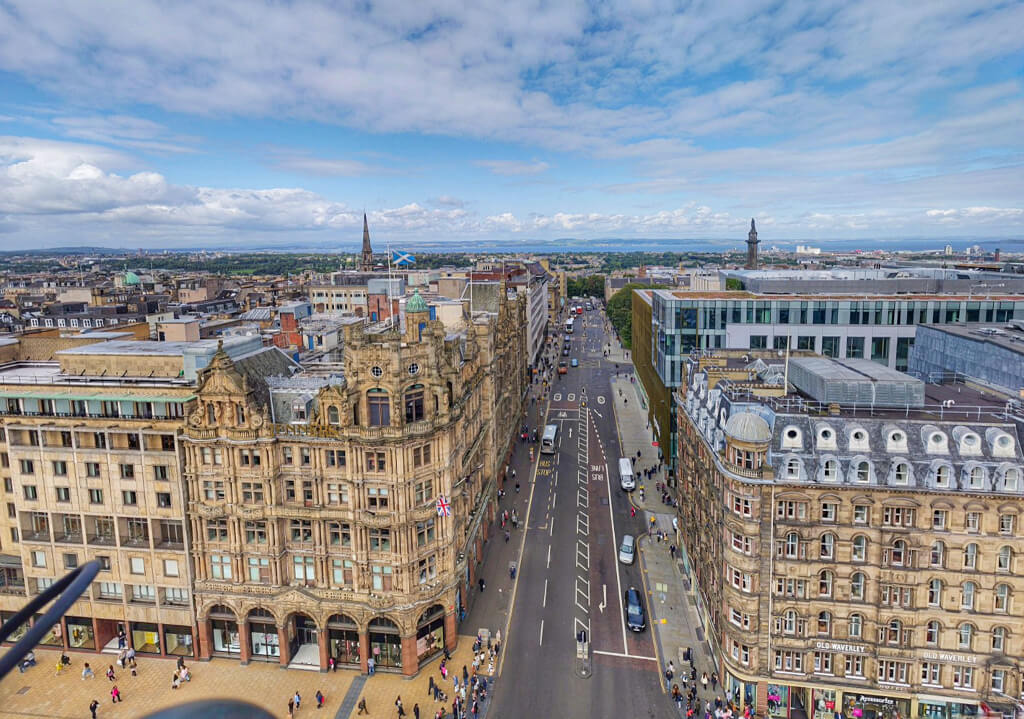If you’re traveling in Edinburgh (and especially if you’re a literary lover!) then you must stop by the Sir Walter Scott Monument. This striking monument to the brilliant Sir Walter Scott dominates the landscape and gives excellent views over the city.
If you want to learn more about what to experience and what to expect while you’re here, then read on to hear about my experience exploring the Scott Monument!
Want to save money while traveling in the UK? Check out my best tips!


What is the Sir Walter Scott Monument?
The Scott Monument is one of the largest monuments to a writer anywhere in the world, standing at 200 feet 6 inches high. (It’s the second largest monument to a writer anywhere in the world!)
The idea for this monument first came after Sir Walter Scott’s death in 1832, when a competition was held to choose a design for a monument to this influential writer. So who designed the Scott Monument? Well, in 1838, a self-taught architect named George Meikle Kemp finally won the contract to use his design to construct the monument.
Meanwhile, a sculptor named John Steel designed a huge statue of Sir Walter Scott and his dog Maida to place on the ground level between the columns of the finished monument. Several other sculptors also created figures of some of Scott’s most well-known characters from his novels to be used throughout the structure.
Luckily for us, this monument was also constructed with a series of viewing platforms that you can reach by climbing up around 287 narrow spiral stairs. You get excellent panoramic views over Edinburgh, and get to explore all that the structure has to offer and all the detail Kemp and others put into this marvelous monument.
Climbing the Scott Monument
One of the most common questions about this place is “Can you climb the Scott Monument?” And as mentioned above, luckily for us the answer is yes!
As a writer and literature enthusiast, I was immensely excited about visiting the Sir Walter Scott Monument in Edinburgh. As the second largest monument to a writer in the world…well, who wouldn’t be excited to visit such a tremendous tribute to an incredible author?
Yet as someone with a love/hate relationship with heights (love the view, terrified of the minuscule possibility of falling to my death), I was decidedly apprehensive about climbing 287 steps up a thin Gothic tower. But it’s a monument to Sir Walter Scott. In Edinburgh. So of course I had to climb it.
I paid the small fee and started up the first spiral staircase. There are actually several levels to the monument, with dimly lit and at times quite skinny staircases leading to each viewing platform. After climbing the first set of stairs, I emerged into the sunlight and then headed straight to the one-room museum dedicated to Scott and to the monument’s architect, George Kemp.

Here, you can learn fascinating information about Scott as well as the architect Kemp. And even this museum room is part of the stunning tribute to Scott as the names of his novels, plays, and poems are carved decoratively into the oak panels alongside the emblems of Scotland (the thistle), Ireland (the shamrock), and England (the rose), while his coat of arms stands carved over the door.


The exhibition room’s intricate and carefully curated design is awe-inspiring, but climbing the monument also allows one to admire up close the incredible detail of the outside facade. While from a distance the building resembles a sand drip castle, when you are closer you can see the astonishing and complicated swirls, statues, and arches that construct the overall lacy texture of the structure.

Some of my favorite details of the decoration are the dog heads carved around the first level (echoing, perhaps, Scott’s dog Maida who is carved with him in statue form on the ground level). The perked up ears and the funny eyebrows of this dog carving in particular made me smile at its pure unexpectedness.
All the particulars of commemorating Scott in this monument make it a writer’s dream destination, but even if you are not a writer or interested in Scott, the stunning 360° views make it worth a climb. Princes Street Gardens stands on one side with its lush, rolling green and myriad of trees and flowers, while on the other side you can glimpse the ocean shimmering in the distance behind Jenners Department Store.
Be forewarned, though, that it can be very windy at the top…which may ruin your selfies or your hair—or both! But there’s really nothing quite like feeling the wind whip through your hair while you stand at the top of a Victorian Gothic tower with panoramic views of Edinburgh. Most certainly an experience of a lifetime!
FAQ About the Scott Monument
Here are a few common questions about the Scott Monument and how to visit it!
When was the Scott Monument built?
While the competition to choose the design for the Scott Monument began in 1832, the foundation stone wasn’t laid until August of 1840. Construction then really began in earnest in 1841 and took nearly four years! Unfortunately, George Kemp himself did not live to see the completion of the monument in August of 1844, but his son was there and put the final piece in place.
What are the Scott Monument hours?
The Scott Monument is open April through September from 10am to 7pm. But October through March, the monument and museum is only open from 10am to 4pm.
How many steps are there in the Scott Monument?
There are approximately 287 steps to get to the top viewing platform of the Scott Monument. I found it to be definitely worth it to get to explore the whole monument and see the amazing views over Edinburgh, but do be aware that these steps get narrower and narrower the further up you go. There was one point where my backpack also almost didn’t fit going into one of the stairwells, so it’s a good idea to carry smaller backpacks or purses on your trek up the stairs.
What is the fee to enter the Scott Monument?
There is a small fee to enter the Scott Monument and climb to the top. Adults pay £8, while concession fees are currently £6 for seniors, children, and students.
Why is the Scott Monument black?
Although the Scott Monument is made of sandstone (which is a pale in color), the sandstone has turned black over the years likely as a result of air pollution and soot. Although the city considered cleaning the sandstone, after much research and investigation it was decided to leave it as it is to prevent any additional damage that could be caused by cleaning it.
Save for Later



